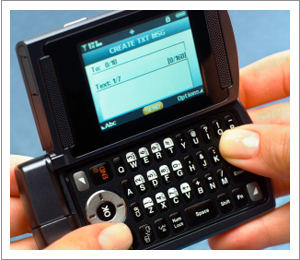European texting - as complicated as A,B,C?
 Brussels - The European Union has three alphabets, 23 official languages and almost 200 individual letters: try fitting that lot on a mobile phone.
Brussels - The European Union has three alphabets, 23 official languages and almost 200 individual letters: try fitting that lot on a mobile phone.
"It is too expensive to offer all 23 languages in the same phone: the size of the memory required will cost too much," Ola Moellerstroem, head of portfolio planning at mobile phone maker Sony Ericsson, told the German Press Agency dpa.
The EU prides itself on its linguistic diversity. Every member state has its official language, and some, such as Belgium, have two.
That leaves mobile phone makers the challenge of fitting multiple alphabets and hundreds of characters onto a device that sits in the palm of your hand.
"Both the hardware and the software that power our devices vary according to local needs. That means different languages for the device's user interface, as well as different key mats," James Etheridge of mobile phone maker Nokia said.
In Greece, for example, Greek is the national alphabet. In Bulgaria, it is Cyrillic.
But many phone users in both countries also want to be able to send SMS messages in languages which use the Latin alphabet.
Some mobile phone keypads in the two countries therefore have Greek or Cyrillic letters above each number and Latin ones below - a system which can make visitors' eyes water.
"Certainly for someone who is not bilingual in both Greek and English, the phone keypad looks quite confusing and crowded. But at the same time I believe that having both languages has forced many Greek people to learn the English alphabet and some basic English words - so overall it is a good thing," said Athenian hairdresser Doria Tsirogoti.
That solution has not caught on in Baltic states, where the Latin alphabet is used for national languages and over 1 million Russian speakers live.
Russian speakers in the Baltics have created a new language - nicknamed "crazy Russian" - to send Russian SMS messages using the Latin alphabet.
"Some of my friends speak Russian, some speak Latvian, some speak English: it just takes too much time to switch between alphabets when I SMS," Svetlana, 32, a financial manager from Riga, explained.
But even in single-alphabet Western countries, the phone is not so much a dance floor for the fingers as a minefield.
There are, for example, nine ways of writing "e" in Europe: alone, with an accent pointing up to the right or left (both French), under a flat line (Latvian), under a triangular "hat" (French), under a v (Czech), under one dot (Lithuanian), under two dots (several languages), and above a comma-like tail (Polish).
If all the options were loaded on a standard 12-key phone, the user would have to hit the same button up to 12 times just to type one character.
To avoid that problem, makers programme their handsets with a selection of characters and languages from one region, and hope, for example, that not too many Finnish users want to text in Maltese.
"Very very few consumers want 23 different languages in the same phone, so you need an expert in how to cluster language packages to fit to market requirements," Moellerstroem said.
But not even that is enough for smart phones with typewriter-style keyboards, because Europe's biggest languages, English, French and German, all lay their keyboards out in different ways - leaving a physical problem which no amount of programming can solve.
"You have QWERTY in the UK, QWERTZ in Germany, AZERTY in France, and so on. Our flagship smart phone, the N97, is sold in 46 languages all in all (globally), with 22 different keypads," Etheridge said.
So next time you send an SMS, think of the poor engineer who designed your phone: it was probably not as easy as A, B, C. (dpa)